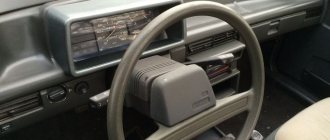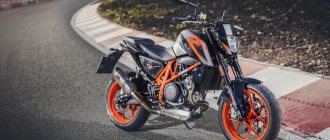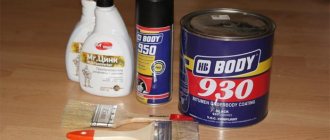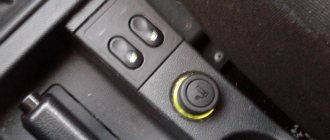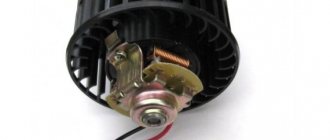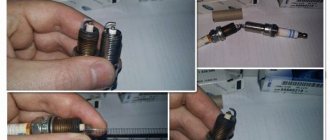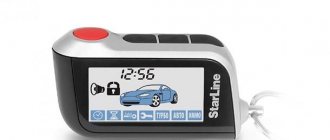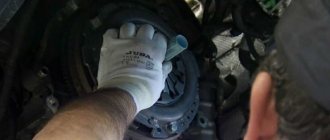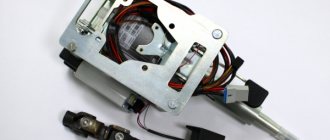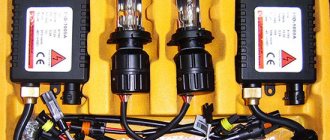Hi all. The other day I purchased Cordon polymer-bitumen mastic. I took 2 cans of 2.5 kg each and a brush of course
Then I opened the jar
Didn’t interfere with the mastic, didn’t heat it in the sun)
I washed the wing. Dried it out. Just in case, I went over it with a metal brush and sandpaper, degreased it and got down to business. The mastic was viscous and therefore comfortable (it didn’t splash or drip). It was quite easy and pleasant to apply to the body. I didn’t skimp on the material at all, I applied it in 2 thick layers with a break of 30 minutes.
Next I applied a second layer, a thicker one. I repeat, I didn’t skimp on mastic. About 30 minutes passed, the mastic had more or less set. I put the wheel back on. I didn’t cover it with a bag or anything else, because... I applied it very carefully and was sure that nothing would drip. I used exactly half the jar, namely somewhere a little more than 1 kg, not bad)
It was starting to get dark... Of course there are no further photos, I was in a hurry. I started working on the second rear wing. I did the same operations. I also applied the remaining mastic in 2 layers, sparing no material. The total layer turned out to be thicker than on the left wing. The lack of time affected the quality; I didn’t apply it very carefully, so it was dripping and there were smudges. After the mastic had set a little, I put the wheel back on, wrapped it in a bag just in case, and left the car for about half an hour. Then, on the advice of my father, I specially drove through dust and fine gravel in order to give strength to the protective layer of the wings. I will put the fender liners back in 2 days, when the material is completely dry.
In the end, it took about 4 hours to complete both wings. The most difficult and time-consuming thing is to wash the wings. Each wing took a little more than 1 kg of mastic. The cost of one 2 kilogram jar is about 250-300 rubles. In the coming days I will be working on the remaining 2 front wings.
I also purchased a rust converter (100 rubles in auto stores). When I put the fender liners back, I’ll treat the screws themselves with mastic and a rust converter. It seems like I haven’t forgotten anything... Thank you all for your attention!
8 for Moscow and Moscow Region
8 for regions of the Russian Federation
Properties and characteristics
Polymer-bitumen anticorrosive agent of the “Cordon” brand in its initial state is a viscous sticky mass of black or dark brown color with a specific odor reminiscent of hydrogen sulfide (indirect recommendation to use a protective mask or respirator). This consistency is convenient because it does not require the introduction of any additives (as we learn from the reviews below, this is not entirely true), and can be applied with a brush or roller up to 120...150 mm wide directly onto the prepared surface.
The presence of bitumen and synthetic rubber in the Cordon anticorrosive composition provides the finished surface with shine and good anti-adhesion from external mechanical particles of gravel, pebbles or coarse sand. Therefore, a number of car enthusiasts in their reviews believe that Cordon also copes well with the functions inherent in anti-gravel compositions. The physico-chemical properties of the composition are maintained up to temperatures of at least 70...800C, therefore Cordon is also positioned as a means of protecting moving parts of a car drive.
Rating of the best anti-corrosion agents
Among the large selection on the market, we offer a rating of popular anticorrosion agents, with prices current for the second half of 2021. The list will allow you to determine which mastic for the underbody of a car is better and how much material is required for specific work.
Anticorrosion series DINITROL
The German manufacturer produces a series of protective products, which include bitumen mastics, oil aerosols, and wax anticorrosives. In dealerships, in addition to original materials, the car is processed using professional tools from the brand.
DINITROL 479 is made on the basis of synthetic rubber and is used as universal protection for external and internal surfaces. Does not contain aggressive components, does not corrode paintwork, plastic, rubber. It has low elasticity, is often used for the bottom, thresholds, provides maximum sound insulation, and is resistant to solutions of acids and salts.
Anticorrosive has high adhesion rates, the maximum period of protection is 2 years, the price on the Russian market is: a 100 ml aerosol can - from 170 rubles. Bottom treatment, 1 liter can - from 700 rubles.
Anticorrosive for the bottom SUPRA-SHIELD
The Russian company produces a full range of materials for complete anti-corrosion protection of the body. The manufacturer insists on carrying out work in its centers and provides a 1-year warranty.
The anticorrosive composition includes adhesive components that increase the adhesion area of the material to the paintwork, viscosity stabilizers, and anticoagulants. The composition repels water, forms a dense layer of protection, and is not destroyed by mechanical stress. Suitable for self-processing the underbody of a car. The cost of a set of 10 liters 5+5 for the bottom and hidden cavities is 4,500 rubles. Among the disadvantages, drivers note the unpleasant odor of the product, so it is necessary to wear a respirator when working.
Anticorrosive PRIM
The Russian company Tekhpromsintez, together with the University of Munich, produces Prim anticorrosion agents for treating all car surfaces. A special feature of the product is its low price for the Russian market. Protective compounds are packaged in aerosol cans and are intended for self-treatment of the body. Products are classified into:
- PRIM BODY. Anticorrosive for external treatment of the bottom. The material forms a matte elastic film on the metal surface, repels water, and is resistant to mechanical damage and the action of reagents. Apply by spray or brush.
- PRIM ML. A product for protecting hidden cavities: side members, door panels, etc. Quickly penetrates microcracks and forms a microfilm. Anticorrosive is resistant to the action of electrolyte, does not destroy paintwork, rubber, and repels moisture. The price of a 1 liter cylinder is from 1000 rubles.
General information
Properties and composition of the product
The protective anti-corrosion agent “Cordon” is sold in different forms - these are tin cans of 1 kg and 2.3 kg, as well as aerosol cans of 0.52 and 0.65 liters, and also in European cans of 1 liter.
The anticorrosive composition is represented by the following components:
- Bitumen.
- Polymers.
- Rust converters.
- Synthetic rubber.
- Corrosion inhibitors.
- Plasticizers.
- Fine fillers.
- Organic types of solvents.
"Cordon" is a high-quality and effective material for protecting materials from corrosion. It is designed for processing external parts and hidden car cavities, as well as for noise protection of the underbody and wheel arches. As the composition dries, a black wax-like coating is formed, impermeable to moisture and has a high degree of adhesion to various paints and varnishes. The product can even be applied to factory paints and varnishes. It has an excellent degree of elasticity, will not deteriorate from vibration, and can also withstand temperature changes ranging from -50 to +100 degrees.
Technical characteristics of the product:
- Appearance: It is a pasty black mass.
- Product consumption ranges from 0.8 to 1 kg per square meter.
- Adhesion is 1 point.
- The proportion of dry residue ranges from 65 to 70%.
- The degree of grinding is from 70 to 100 microns.
- Impact strength is 50 kgf per cm.
- The conditional degree of viscosity ranges from 60 to 150 s (according to a special device VZ-246).
Now let's look at the advantages of the product.
Advantages of anticorrosive
“Cordon” will be highly effective against rust. It is resistant to water, makes the surface airtight, and therefore corrosion will stop developing. The product can be called thermally stable, because it easily tolerates both cold and heat up to + 100 degrees and can be used in any climate.
Please note that the product is universal and can be used to protect any metal products and structures from damage to the car body. Another product can be applied to wooden types of surfaces or used on other types of bases to protect against moisture and for noise insulation.
Bituminous anticorrosive agent "Cordon" is easily applied to surfaces that have not undergone preliminary preparation, and to parts that have been previously treated with this product. The composition will be ideally combined with paints and varnishes, and the degree of its adhesion will not decrease under any weather conditions. The waxy layer cannot be washed off even when using cleaning products.
Features of using anti-corrosion bitumen primer - Do-it-yourself car painting
Among anti-corrosion protection agents for the underbody of a car, bitumen primer is deservedly popular.
The aesthetic characteristics of such compositions are low, but for the underbody of a car, the quality of the coating, such as resistance to moisture, sand, and small stones, comes to the fore.
If work is not carried out in a timely manner to protect the underbody of the car from the effects of precipitation, then it may subsequently undergo corrosion.
The advantage of using bitumen mastic for anti-corrosion protection of cars:
- bituminous binder;
- fillers.
Bitumen anti-corrosion mastic for the underbody of a car has many advantages:
- High elasticity, which is maintained even in the cold season.
- Provides durability and reliability of the coating.
- No additional equipment is required to apply the composition to the underbody of the car. If there is no lift, you can use the garage inspection pit.
- Affordable price. Mastics are somewhat cheaper than active-type protective agents.
In addition, mastic can be used to locally restore damaged coating without removing the entire layer of protection. If cracks or gaps appear on the old protection, then the composition is applied pointwise, directly to the damaged area. In this case, it is important to use the same type of mixture that was applied previously.
The consumption of the composition per m2 is always indicated on the packaging. But this is only an approximate idea of how much primer is required per 1 m2.
Consumption per 1 m2 depends on the absorbency of the surface and the number of layers applied. Typically, bitumen primer is applied to the external body structures of a car in 2-3 layers. And the amount of material used depends on the skill of the master - an experienced specialist uses less primer.
The consumption of the material also depends on its consistency. Also, the consumption per m2 will be different when working with a brush, staple or spray gun. On average, the consumption of bitumen primer is as follows: 1 container (15 liters) is usually enough to treat 50 m2.
Features and characteristics of rubber-bitumen compounds
Rubber-bitumen mastic materials are a mixture that includes:
- liquid rubber (rubber);
- bitumen solution;
- plasticizers.
Liquid rubber, after drying, serves as an effective barrier to harmful influences. Anti-corrosion protection of the underbody and wheel arches of a car with this composition has a noise-insulating effect and prevents the appearance of rust.
Among other things, rubber-bitumen mastics maintain operating temperature conditions and are highly resistant to salt reagents, flying small stones and sand.
Rubber-bitumen protective materials have a fairly low cost.
The most common rubber-bitumen primer is Kerry mastic. This is a highly effective cold-applied rubber-bitumen anticorrosive agent. By creating a uniform impact-resistant film, the Kerry composition perfectly protects the underbody and wheel arches of the car from corrosion and rust. The coating is impermeable to moisture, air and aggressive environments.
Kerry mastic serves as additional noise insulation, perfectly absorbing sounds. It can be applied to factory coatings. Highly elastic Kerry mastic has a significant degree of adhesion and wear resistance. The anti-corrosion mixture has improved strength characteristics.
Article: CORDON
Order code: 030414
In stock Available for order – >10 pcs. Data updated: 05/29/2021 at 00:30
Order code
030414 Articles CORDON Manufacturer POLICOMPLAST Width, m: 0.1 Height, m: 0.15 Length, m: 0.1 Weight, kg: 1.1
Product reviews
Reviews
There are no reviews for this product yet.
Write a review
Articles about the product
- Anti-corrosion treatment is the best protection for a car from rust May 8, 2013 One of the worst enemies of metal is corrosion. Even when purchasing an expensive foreign car, not to mention domestic cars, you must immediately take care of anti-corrosion protection. Indeed, the body begins to collapse literally in the first months of operation of the car, so you cannot hesitate.
- Anticorrosive polymer-bitumen 1l Cordon POLICOMPLAST Article: CORDON Order code: 030414 259 ₽ or place an order by calling 8 800 6006 966
Availability of goods in warehouses and stores, as well as the price of the goods is indicated on
29.05.2021 00:30
.
Prices and availability of goods in all stores and warehouses are updated once an hour.
If there is a sufficient quantity of goods in the store you need, you can buy it without pre-ordering. Internet price
– valid when ordering on the website or through a call center operator by phone
8-800-600-69-66
. Subject to sufficient quantity of goods at the time of order.
Price in stores
– retail price of goods in store sales areas without pre-order.
The period for moving goods from a remote warehouse to the warehouse of an online store.
The parts data presented on this page is for informational purposes only.
656dd4a44fc4c621f0b389830d37f053
Add to cart
Available to order:
Order quantity:
Product successfully added to cart
!
Selection criteria and requirements
Many drivers, when choosing a model in the budget segment, carry out anti-corrosion treatment of the body in the first months. This is justified when purchasing Chinese vehicles, some Renault, Chevrolet models, etc.
Recommendations when choosing:
- It is better to apply a liquid substance with a pistol; choose homogeneous elastic compounds.
- The internal cavities of the body are treated with non-drying oil products.
- The use of paraffin anticorrosives will prevent moisture from entering and slow down the oxidation of body parts that have not undergone production galvanizing.
- External treatment of the bottom is carried out with bitumen mastic, PVC rubber, and liquid plastic. Homogeneous compositions are selected. The machine must be installed on a lift.
- All products have a limited lifespan.
- Average calculation of the amount of material for the outer part of the bottom: 1 liter of anti-corrosive agent per 1 sq. m of surface.
Before choosing an anti-corrosion protection product, it is necessary to check the condition of the metal and, if necessary, carry out repairs.
Components and features
Cordon anticorrosive for protection against rust is produced in different volumes - cans of 1 and 2.3 kg, cans of 520 and 650 ml, and there are also Euro cans of 1000 ml.
This anticorrosive contains the following substances:
- Bitumen.
- Polymers.
- Rust inhibitors.
- Corrosion converters.
- Artificial rubber.
- Filler (fine dispersion).
- Plasticizer.
- Organic thinners.
Cordon is a material of high quality and efficiency that reliably protects the metal base from rust. It is needed to protect external parts, hidden areas of the car, as well as to protect the bottom and wheel arches.
After drying, a black coating is formed, similar to wax, does not allow moisture to pass through, and has good adhesion to various paints and varnishes.
They can be used to cover surfaces that have factory paints and varnishes. The substance has a high level of elasticity, vibration does not affect the coating, and tolerates different temperatures from -50 to +100.
Technical indicators of anticorrosive:
- Externally it is a black ointment.
- Consumption – up to 1 kg/sq.m.
- Clutch – 1 b.
- Dry fraction – up to 70%.
- Grinding – up to 100 microns.
- Strength before impact – 50 kgf/cm.
- Viscosity level – up to 150 s.
Customer reviews about the use of rubber mixture
Anonymous2465668: “This nuclear mixture never solidifies. It will saturate all microcracks and rust without spreading. further. PROVIDED THAT YOU MIX ALL THREE COMPONENTS! It will stink for a year. So I don’t recommend pouring this into the sills, not to mention the inside of the car.”
Alexey B.: “Mastic really works for a solid four. I really liked applying it to the underside of the car. The application stain does not spray in different directions and dries quickly. After using it for about a month it did not come off. It hardens into rubber.”
Alexander: “Excellent adhesion with the formation of an almost even layer that quickly weathered. I applied it in 3 layers to a crumpled, slightly scratched threshold, the layer turned out to be elastic, I think it will be impact-resistant, and therefore anti-corrosion resistant. It is written that it should be used from +10 to +30, sprayed at +3 - the flight was normal. Everything went smoothly. Thanks to the manufacturer.”
Anticorrosive Cordon®
- Aerosol packaging
- Tin can
- Euroballoon
- Promtara
TU 2384-015-61736206–2011
| vendor code | Type of packaging | Net weight | Quantity per box |
| PA008B1000 | Tin can | 1.0 kg | 16 pcs. |
| PA008B2300 | Tin can | 2.3 kg | 6 pcs. |
| PA008A0520 | Aerosol can | 520 ml | 12 pcs. |
| PA008A0650 | Aerosol can | 650 ml | 12 pcs. |
| PA008A01000 | Aerosol can | 1000 ml | 12pcs. |
| PA008E1000 | Euroballoon | 1000 ml | 12pcs. |
| Metal bucket | 20 l/14.5 kg | ||
| Metal barrel | 50 l/32 kg | ||
| Metal barrel | 200 l/130 kg |
offers for sale Cordon anticorrosive agent, which has high efficiency and universal action.
Application
All manufacturers (the main one is ZAO PoliKomPlast, Moscow region) strongly do not recommend using Cordon in combination with other anti-corrosion protection products. It is indicated that in this case good adhesion of the coating to the metal cannot be guaranteed. Before use, clean the surface from dust, loose particles, oils and grease. Next do:
- Applying the first layer of anticorrosive as a base layer. This layer must be thoroughly dried for 4...6 hours; Due to the flammability, it is not recommended to use forced drying.
- Since the layer must be applied with a brush or roller (PolyComPlast also produces an aerosol version of Cordon, but it is not in great demand among car enthusiasts), after drying it is necessary to inspect the surface. There is a possibility of cracks, the cause of which is considered to be an unacceptable temperature difference between the ambient air and the anticorrosive. Cracks are sealed with any auto sealant, except anaerobic. For final sealing of the coating, at least a day must pass.
- The original Cordon composition is mixed. So from the manufacturer; in fact, the anticorrosive agent will have to be heated on the stove or (which is less effective) in a water bath. During heating, the anticorrosive agent may ignite, which is not a defect. It is necessary to allow the surface layer, which has a greenish color, to burn out, after which the burning will stop; This will not affect the quality of the coating.
- The layer is dried for at least 8 hours, and it is advisable to avoid drafts and sudden temperature changes in the room where the treatment is performed. If necessary, the treatment is repeated, but also with an interval of 8 hours. The minimum recommended thickness of the anti-corrosion coating cannot be less than 1 mm.
- After handling, you must thoroughly wash your hands and used tools. The anticorrosive agent must be stored in a container away from air and direct sunlight at a temperature not lower than 50C.
What is the difference between mastic for thresholds?
It is recommended to use mastic for external thresholds and the underbody of the car. The material is classified according to the composition of its components, the most common being:
- bitumen-polymer;
- rubber bitumen;
- epoxy.
The highest anti-corrosion effect is shown by epoxy mastic, the main disadvantage of which is considered to be instability to low temperatures. At levels below 100 C, the composition may crack.
Drivers prefer to use rubber-bitumen mastic, which is easy to apply with a brush yourself. The average service life of the train is 100,000 km.
Professional locksmiths recommend using the anti-corrosion compound Antigravel for treating thresholds, which, after application, is painted with a suitable paint. Mastic is used to treat the bottom, arches and trunk floor. Thresholds treated with mastic look unsightly; it is necessary to use overlays.
Instructions for use
Preparation
Before using anticorrosive, the surface must be degreased, cleaned of all contaminants, and peeling coatings must be removed. Also, immediately before applying the base, everything should be dried as best as possible. If the composition is purchased in a metal container, it should be applied with a brush or roller. With a high degree of density, it is important to dilute the product with gasoline, solvent and white spirit. The optimal temperature during work will be no less than +15 degrees.
Recommendations for application are as follows:
- The first layer is the base layer, and it should be thoroughly dried for 4 to 6 hours, no less.
- Forced drying is not recommended because the composition is flammable.
- You should do 2-3 layers with intermediate drying for 1 hour.
- At the end of the work, the coating should be left for 24 hours, and only after that begin operation.
- When drying is completed, it is important to avoid drafts and sudden temperature changes.
- If necessary, after the drying process the coating should be applied again (as a rule, this happens when the layer thickness does not become more than 0.1 cm).
Before use, the aerosol can must be shaken vigorously for two minutes, and then the composition must be sprayed by pressing the valve head. European spray cans should be shaken and attached to the gun, and the pressure should be set to 3 to 6 bar, and the composition should be sprayed onto the surface at a distance of 0.2 to 0.3 meters. Make 203 layers with intermediate drying for 1 hour. When working, you should never smoke near the can and allow contact with open fire, heating devices, or static electricity.
Please note that you should always work with this product wearing rubber gloves in an open space or in a well-ventilated room, because it contains substances harmful to human health. After finishing the treatment, the instruments should be washed with special solvents. The remainder of the product can be stored in tightly covered containers at temperatures from +10 to +55 degrees.
Application Features
Instead of adding a solvent to dilute the anticorrosion agent, you can slightly heat the composition. To avoid ignition, this should be done in a water bath. If ignition does occur, the top layer, which has a greenish tint, should be allowed to burn out and the process will stop. If necessary, a wet cloth should be placed on the surface to stop oxygen access. The quality of the coating will not be affected by fire, and the composition can then be used for its intended purpose.
Other recommendations for working with anticorrosive agents:
- After drying, the coating should be carefully inspected. Sometimes cracks appear on it due to temperature differences between the composition and the environment during application. To eliminate such defects, you should buy automotive sealant (any except anaerobic), seal the cracks, and leave to dry for a day.
- The spray gun is not recommended for applying the Cordon bitumen-polymer anticorrosion agent. This will seriously increase consumption, and there is also the possibility of getting an uneven layer thickness.
- If the compositions are viscous, they can be applied using a spatula - this processing option is quite acceptable. And yet, with a high density of anticorrosion agent, you should heat it up a little during work.
- When the composition has dried completely, its appearance resembles a glass mass with a characteristic shine. If the coating appears different, this will indicate that it has not fully cured and drying is important.
- In order to enhance the effect of noise insulation, craftsmen recommend adding small amounts of crumb rubber to Cordon. Typically this technique is used for treating external surfaces.
- To remove anticorrosion, you can use organic solvents, preferably acetone or white spirit.
Coverage nuances
To dilute a substance, sometimes they do not use solvents, but simply heat the mixture.
To prevent it from catching fire, this is done using a water bath.
If there was a fire, wait until the top of the green tone burns out and everything is completed. If necessary, place a dampened rag on the layer to prevent oxygen from entering. This will not affect the quality of the product in any way, and the anticorrosive agent can then be used for its intended purpose.
Important tips when working with Cordon:
- After complete drying, you need to thoroughly inspect the base. Cracks may form due to temperature changes and the general environment during the procedure. To prevent this, buy a sealant for the car, cover the defects with it and wait 24 hours for it to dry.
- It is better not to use a spray gun for anticorrosion. Since there will be a lot of consumption with it, and the result may be a layer that is not the same in thickness.
- If the anticorrosive agent is thick, then you can work with it with a spatula - this option is possible. But, if the viscosity is very high, then it is better to heat it up a little.
- After complete drying, the coating turns out like glass melt with a specific shine. If the layer looks different, it means complete hardening has not yet occurred and you need to give it a little time to dry.
- To better protect against noise, you need to add a little bit of rubber crumbs to the anticorrosive. Most often, this option is made for external work.
- An organic thinner is suitable for removing Cordon; acetone or white spirit are excellent.
Quality indicators
| № | The name of indicators | Specifications requirements | |
| Cordon* | Cordon-A** | ||
| 1. | Appearance | Black paste-like mass | |
| 2. | Mass fraction of non-volatile substances, n/m, % | 70 | 65 |
| 3. | Coating adhesion, n/b, points | 1 | 1 |
| 4 | Degree of grinding, µm, n/a | 100 | 70 |
| 5. | Coating strength upon impact, kgf.cm, n/m | 50 | 50 |
| 6 | Heat resistance of coating, points, n/m | 100 | 100 |
| 7 | Conditional viscosity according to VZ-246 (4) at (20 ±0.5)°C, s | – | 60-150 |
| 8 | Protective properties of coating in 3% NaCl solution, points, n/m | 100 | 100 |
* for packaging in tin cans ** for packaging in aerosol and euro cans
Where else can the product be used?
Use in construction and other areas. Despite the fact that this mastic is required for treating a car body against rust, it is widely used for other purposes:
- Create a hydrophobic coating on metal structures, wooden structures, concrete, including those working deep into the ground (layer up to 0.1 cm).
- Protection of concrete supports, foundations, wall surfaces that are constantly exposed to moisture (layer up to 0.07 cm).
- Anti-corrosion coating of pipelines, containers and other metal products (layer up to 0.15 cm).
- Renewal of old roofing materials by simple painting (layer up to 0.03 cm).
- Sealing seams and joints on all kinds of structures (a dense layer until the cracks are perfectly closed).
- Priming bases made of concrete, brick, and other building materials before starting finishing work, as well as gluing parquet, floor slabs, and applying insulation (a thin layer when diluting “Cordon” to the state of simple paint).
Anticorrosive is often used to coat greenhouses, garages, roofs and fences to protect them from rusting and damage from moisture. It helps save wood from rotting and is widely used in the construction of soft roofing. Its versatility, ease of use and efficiency make the composition extremely popular in industry, automotive repair and domestic use.
( 2 ratings, average 5 out of 5 )
Use in construction and other fields
This anticorrosive agent is designed to protect the car body from corrosion, but it is also used in other areas:
- Obtaining hydrophobic layers on structures made of metal, wood, concrete, even those that work in buried soil (layer up to 1 mm).
- To protect concrete supports, walls, and foundations that are constantly exposed to moisture (up to 0.7 mm).
- To create protection against rust on pipelines and various metal products (up to 1.5 mm).
- Overlapping of old materials on the roof (as simple painting, layer no more than 0.3 mm).
- Sealing joints and seams on different surfaces.
- Like priming surfaces of concrete, brick, various materials before finishing, laying parquet, slabs on the floor, laying an insulation system (the substance is diluted to the thickness of simple paint).
Often “Cordon” is purchased to cover garages, stairs, various structures, fences, so that moisture does not appear on them and does not begin destructive processes.
“Cordon” protects wood that has begun to rot and is often used for soft roofing.
This composition is in great demand in industry, in car repairs, and in everyday life, because it has a universal composition, is easy to work with, and gives good results.
Automotive mastics
Is there a difference between ordinary bitumen rubber mastic and a similar composition for waterproofing the undersides and arches of cars? In principle, there is no difference. The only difference is the finely dispersed automotive grade technical rubber in the composition. Of course, in order to improve the quality of the material itself, manufacturers add plasticizers to it. With their help, they achieve improved quality in terms of impact resistance. It’s no secret that the bottom of a car and its arches are subject to impacts from stones flying out from under the wheels at high speed. Therefore, automotive mastic must withstand such loads when applied in a thin layer.
Anti-corrosion treatment for cars
Although the main purpose is anti-corrosion resistance. It should be noted that bitumen itself is already an excellent protection against metal corrosion. But manufacturers don't stop there. Today on the market you can buy more modern and high-quality rubber-bitumen mastics, to which various oils are added, especially of vegetable origin. They increase resistance to corrosion.
Plus, in addition to crumb rubber, aluminosilicates are also used as fillers. These additives increase sound insulation. Manufacturers today are trying to find the optimal ratio of components in order to increase the performance properties of rubber-bitumen mastic.
POLICOMPLAST - anticorrosive (Cordon), primers, putties
is the exclusive distributor of PolyComPlast products in the Ulyanovsk region.
About company
The enterprise OJSC "Polikomplast" was founded in June 1991, on the territory.
The dominant activity of the enterprise was the production of materials for car maintenance and repair. Throughout its existence, the enterprise not only grew, but also developed methodically. The Polikomplast brand was an innovator in the Russian automotive chemicals market, and today it is one of the most recognizable and popular brands among buyers of quality products.
The product line includes products such as anti-corrosion agents, putties, primers, anti-corrosion products, and products for working with car enamels and paints.
Thus, anti-corrosion coatings “Polikomplast”, designed to protect external and hidden metal surfaces of the car and anti-noise protection of the underbody and wheel arches - “Avtomovil”, “Inkor”, “Cordon”, “Barrier” - help solve rust problems.
Zinc-based corrosion inhibitors have long proven themselves on the market. , in turn, produces products such as Bitsink and ZincoMovil, which complement the anticorrosive line.
The line of rust converters - “OMEGA”, “Autotophosphate” will get rid of rusty deposits and create a protective film that prevents its further appearance.
“Auto Wash” will help you prepare the body for painting, which will quickly remove old paint coatings of all types from metal, ceramic, glass, concrete, and wooden surfaces.
Automotive putties produced by Polikomplast have consumer properties at the level of the best foreign samples, and surpass them in a number of indicators. Automotive putty from the “Tineisik” series is intended for professional use in auto repair; used to eliminate defects on metal and some non-metallic surfaces that can no longer be eliminated by straightening.
Automotive primers GF-021 and GF-021M can serve as the basis for putties and paint and varnish enamels. They can be used not only in car repair, but also in everyday life, as well as for temporary protection of metals from corrosion during storage. The advantages of GF series primers are that they can be applied to both metal and wooden surfaces. To reduce the temperature and drying time of primers, there is an enamels hardener produced by Polikomplast - "Diur", and also to prevent yellowing of light enamels - "Diur-Extra".
